Pterotrachea
coronata (Forskål, 1775)
by Walter Jung and Maike Kussinn

 e started diving in 1993, had our course in
Germany and finished it with the Bronze brevet of VDST (equivalent to CMAS *). Diving in
Germany means for us to go into a dark and cold gravel pit. Whom it surprises: We wanted
to have a look for ourselves to all the wonderful things in the sea which the other divers
of our diveclub "TG Mölln" were adoring. So we decided to go to the Costa Brava
(Spain) in autumn. e started diving in 1993, had our course in
Germany and finished it with the Bronze brevet of VDST (equivalent to CMAS *). Diving in
Germany means for us to go into a dark and cold gravel pit. Whom it surprises: We wanted
to have a look for ourselves to all the wonderful things in the sea which the other divers
of our diveclub "TG Mölln" were adoring. So we decided to go to the Costa Brava
(Spain) in autumn.
We were the proud owners of a
beautiful, multicolored caravan, and it was a joy to drive and dive the coast up and down.
We admired enormous groupers in L'Estartit, large sea-hares in Tamariu, large and small
octopus,
Spanish lobsters, electric rays, congers, lobsters,
etc.
Because we found everything so wonderful, we go
frequently to this beautiful coast. We even inspired some diver friends to go to this
diving area. We became so used to the idea, that in October we all went to the Costa
Brava.
Only that this year it would be different, because
we travelled in spring, with the thought that perhaps there will be something else to
see. And so was it.
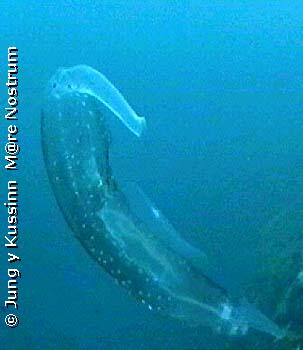 In Tossa de Mar we had the feeling of not diving in water, but in
a fish egg soup. We were speechless. We had to push the egg strings away
with
our hands. Fulleaten fish chewed boringly the fish eggs around. In Tossa de Mar we had the feeling of not diving in water, but in
a fish egg soup. We were speechless. We had to push the egg strings away
with
our hands. Fulleaten fish chewed boringly the fish eggs around.
And then, in Tamariu, occurred something that
started us the idea of writting this small article. During a beach dive in the bay of
Tamariu (Stolli's diving center) we could film and observe this strange organism in 5 m
depth of water.
My buddy Maike Kussinn discovered it. It
was my dive number 557 and the date was April 12, 1999. At first the animal layed quietly
and looked as if it was asleep. While I rounded and filmed the animal, it seemed it to
wake up and circled us, as if it was closely examining our equipment.
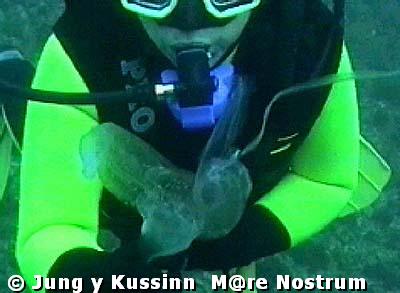
DESCRIPTION OF THE ANIMAL
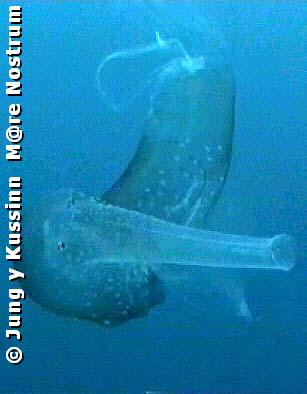 It had a size about 30 cm long, with a diameter about 5 cm,
sausage-like body, transparent like a jellyfish and button black eyes equipped with a long
trunk. The animal moved with some transparent swimming fins under the body. It had a size about 30 cm long, with a diameter about 5 cm,
sausage-like body, transparent like a jellyfish and button black eyes equipped with a long
trunk. The animal moved with some transparent swimming fins under the body.
We described the organism to many local dive
guides, but nobody could tell us a word about the animal, even approximately.
Only Dr. Peter Nahke brought clarity to the
problem in July 1999: It belongs to the superfamily of the Atlantoidea,
whose 3 families appear described in the Mediterranean. It is a pelagic slug, i.e. it
constantly swims in middle waters far from the coast where it becames extremely rare.
Professor Dr. Dieter Adelung (Oceanographic
Institute of the University of Kiel), in a letter to us, identified with a 90% confidence
rate that it is a Pterotrachea coronata.
We are very interested in the underwater flora and
fauna. We have many underwater films already made, e.g. from Ireland, France, Spain,
Norway, Croatia, Denmark, Red Sea, Maldives, Cuba - but such an animal never came before
our camera lens.
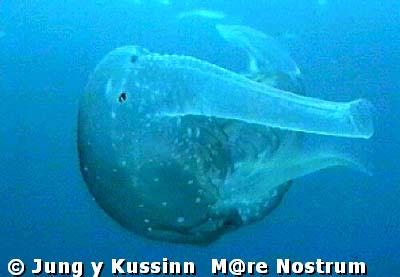
SYSTEMATIC CLASSIFICATION
- According to Check List of European Marine Mollusca
Superclass: MOLLUSCA
Class: Gastropoda (Cuvier, 1797)
Subclass: Prosobranchia (Milne Edward, 1848)
Order: Apogastropoda (Salvini, Plawen & Haszprunar, 1987)
Suborder: Caenogastropoda (Cox, 1959)
Superfamily: Firoloidea (Rafinesque, 1815)
Family: Firolidae (Rafinesque, 1815)
Genus: Pterotrachea (Forskål, 1775)
Species: coronata (Forskål, 1775)
- According to Rupert Riedl's book: Fauna and
Flora of the Mediterranean
Tribe: Mollusca (soft
animals)
Subtribe: Conchifera (bowl soft animals)
Class: Gastropoda
Subclass: Prosobranchia
Order: Caenogastropoda
Suborder: Mesogastropoda
Superfamily: Atlantoidea
Family: Pterotrachidae
Genus: Pterotrachea
Species: coronata (Forskål, 1775)
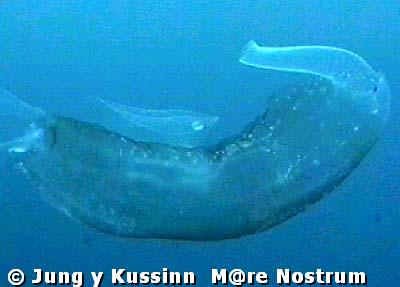
ACKNOWLEDGEMENTS
- All pictures are from a UW video by Walter Jung
- The classification first took place thanks to Dr.
Peter Nahke
- Identified (with 90 % confidence) as Pterotrachea
coronata by Prof. Dr. Dieter Adelung
- Report by Walter Jung and Maike Kussinn
- Erwin Köhler looked for the specification up to
systematics and created the original web pages.
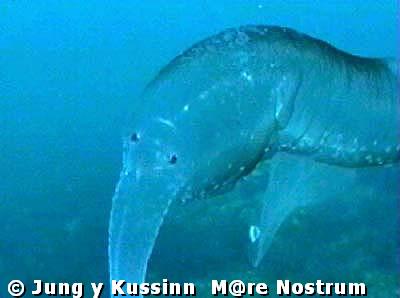
DIRECTORY
Walter
Jung
Silberberg 23
23911 SALEM
Germany
Tel.: 04541 - 8 25
45
Fax: 04541 - 85 86 74
E-Mail: Jugendheimes Salem
WWW: Jugendheimes Salem |
Dr. Peter Nahke
Tauchen
Jessenstraße 1
22767 Hamburg
Germany
Fax 040 - 38 90 63 03 |
Prof.Dr. Dieter
Adelung
Institut für Meereskunde
an der Universität Kiel
Düsternbrooker Weg 20
24105 Kiel
GermanyTel. 0431 - 597 - 38 30 |
Erwin Köhler
Bruckner-Straße 71
64291 Darmstadt
Germany
Tel. 06150 - 8 56
34
eMail: Medslugs
WWW: Medslugs |
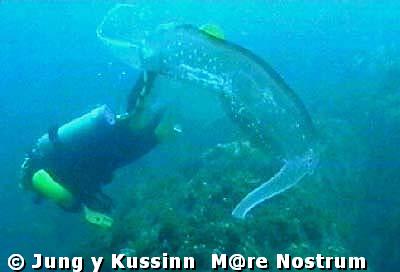
 |